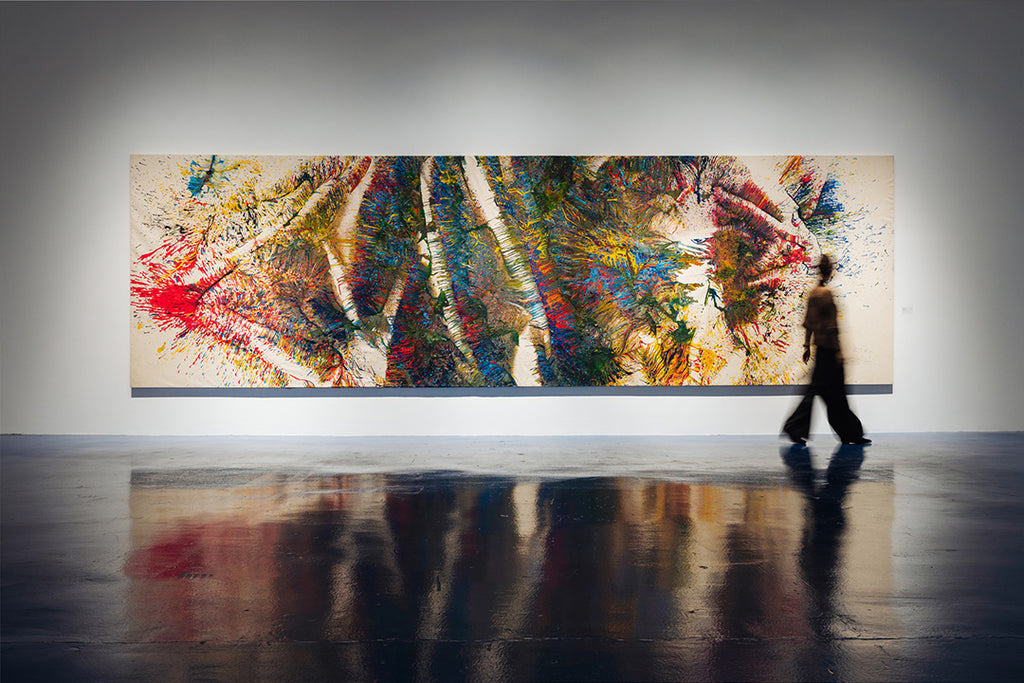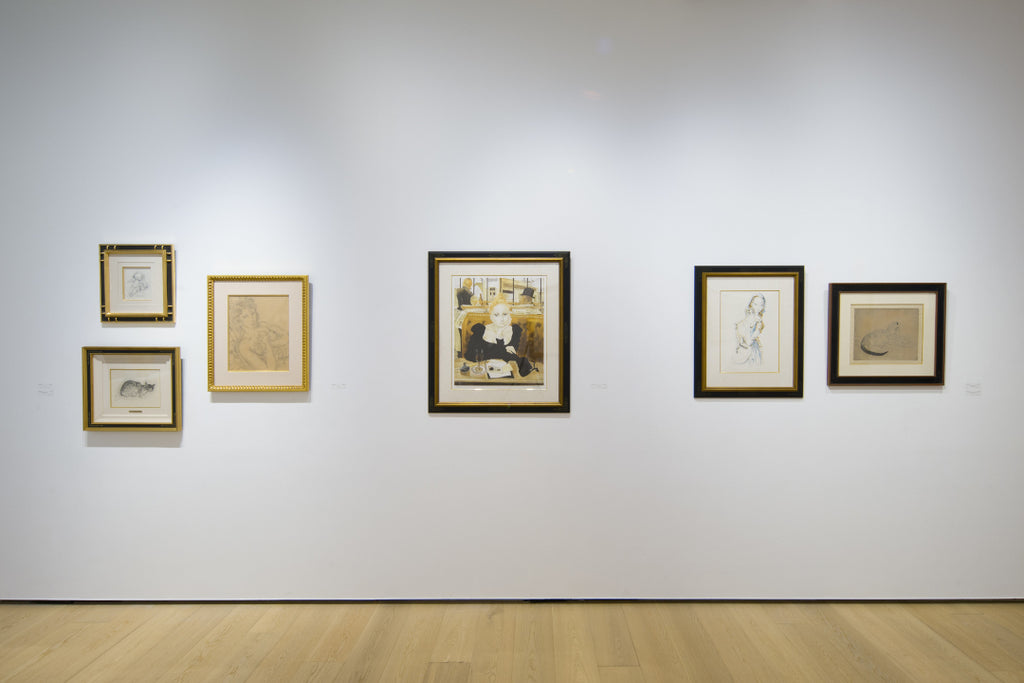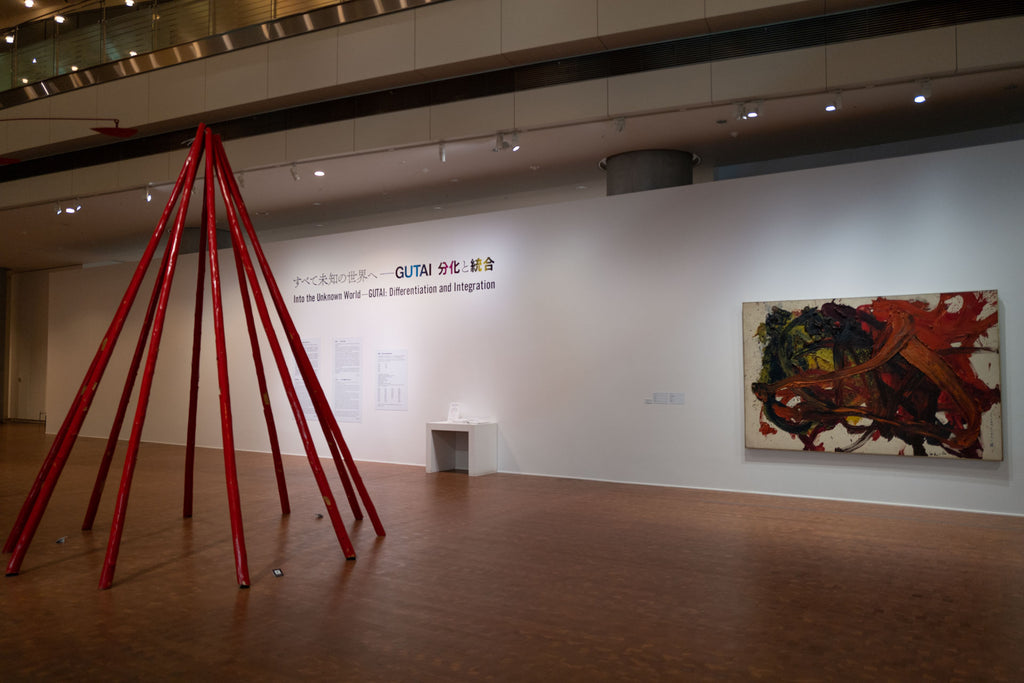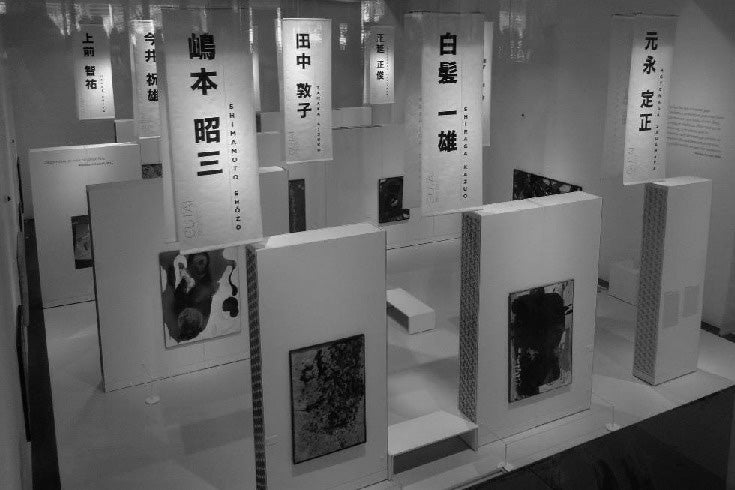ARTICLES
Shuji Mukai's Remarks: The Reality of Gutai and its Lack of Ideological Background
GUTAI STILL ALIVE 2015 vol.1
10/35
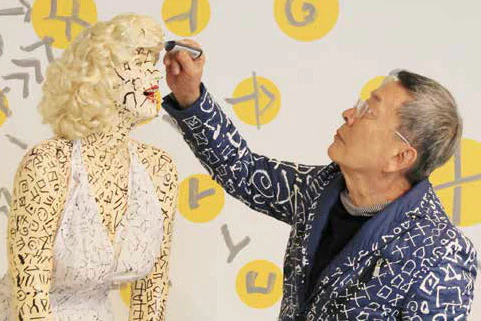
Shuji Mukai
A project evolving the digitized archive of the book, “GUTAI STILL ALIVE 2015 vol.1”. The 10th edition features a dialogue between former Gutai Art Association member, Shuji Mukai and art historian, Kunio Motoe. Their light-hearted talk reveals their first-hand knowledge into the realities of the Gutai.
From negation of conventional “painting” toward “signs”
An Interview of SHUJI MUKAI by Kunio Motoe
Motoe: Recently I feel that Gutai was indeed a treasure house of talent.
Mukai: Jiro Yoshihara, the leader of the Gutai group, put forth unconventional ideas and created an atmosphere suited to such ideas. Members who didn’t like such ideas left the group early but, as you said, those who remained in the group were all artists with unique individualities. The nucleus of Gutai was formed by Shozo Shimamoto and other former members of the Modern Art Association. In addition, Atsuko Tanaka, Saburo Murakami, Akira Kanayama and Kazuo Shiraga, who joined Gutai after disbanding their Zero Kai group, conferred intelligence on Gutai and upgraded its status considerably.
Motoe: I see. That’s the history of Gutai. Those who left Gutai did so because their sense of beauty didn’t match Yoshihara’s, right?
Mukai: I guess they wanted more freedom. Yoshihara hated the smelly and dirty, and even wanted his fellow painters to wear a tie when they gathered. No other artists’ groups could be so strict about manners. He had come from a very good home.
Motoe: That’s intriguing! I heard such an anecdote for the first time.
Mukai: Gutai Pinacotheca*, named by Michel Tapié, was a storehouse of the Yoshiharas since the Edo period. Yoshihara couldn’t get along with the Nika group of artists, so he became independent and founded Gutai, to do what he wanted. That also indicates his indulgent background. Twice a year or so, Gutai members used to bring in their works to Yoshihara’s home in Ashiya for screening. We almost met together at exhibition openings only. We dined all together only once in the 18 years of Gutai’s existence. We had little opportunity for discussing art, and we weren’t engaged in the administration of the group either. Thanks to the Yoshihara Seiyu (oil) company, run by the Yoshihara family, the member’s fee was inexpensive, it was said. Nevertheless, running the group cost much more than Yoshihara had expected, so he recruited more members. Some new members brought in sculptures. That was a crucial time for Gutai.
Motoe: Was everyone conscious of being a member of Gutai?
Mukai: After Tapié introduced Gutai to overseas, they were. Because it’s safer to stick to a well-known organization. Tapié was an art dealer too. He held successful exhibitions around the world, and Jasper Johns and other top artists visited Gutai Pinacotheca one after another. The Japanese only appreciate what’s appreciated in overseas.
Motoe: I once watched some news footage showing Shiraga at a Tokyo exhibition. I indeed felt some kind of sarcasm in the footage.
Mukai: Yes, people in Japan used to be sarcastic to us.
Motoe: But Gutai took a very important position in postwar art history in Japan. Overseas appreciation showed that Gutai’s art was highly marketable. How did you get further involved in Gutai?
Mukai: I didn’t know anything about Gutai, and was first influenced by Shiraga. In an exhibition in Kyoto, I saw eight of his works of size No. 200, and wondered what kind of person he was. Shiraga was commonly known as a painter who painted with feet, but I felt from his works a consciousness of “getting in the paintings.” Until that time we used to paint thinking a painting to be an object. Then I tried to negate all the “painting” of the past, stopped using paints and paintbrushes, and even used sand instead. In my work “A Room and Signs” I created a room with the frame and I myself got in it (in the form of signs), which reflected the same viewpoint as Shiraga’s, I believe. Then Akira Kanayama influenced me. A machine like the Roomba automatic vacuum cleaner moved around and applied paint automatically. The artist just sat down and was snoozing beside it. “Mr. Mukai, you only have to decide at which point you should stop,” he told me. Even though it was automatic painting, you had to decide when it was to be completed. I was greatly influenced by such interesting methodology.
Motoe: Artists who can tell by whom they have been influenced are rare. You can tell it frankly because you are self-confident enough, I guess.
Mukai: That means there aren’t that great people around me (laughter).
Motoe: That’s disappointing (laughter).
Mukai: I can tell it because I know them in person. The work has nothing to do with the artist’s person.
Motoe: Of course – but I thought there was something more vivid.
Mukai: Vivid? What do you mean by that?
Motoe: You members often quarreled with each other, didn’t you? Or rivaled each other excitingly... .
Mukai: Everyone was vigorous and ambitious, certainly. No one was ill-natured nor backbit others like in other organizations. But I was fortunately successful already in my 20s. Tapié bought my work each time he visited Japan. I exhibited my work along with works by Insho Domoto, Sofu Teshigahara and Jiro Yoshihara in the exhibition “Repetitive Structures” at Galerie Stadler in Paris. My fellow artists weren’t very happy at that, I guess. Actually my works weren’t selling at high prices and I was anxious about the works I had deposited with the galleries.
Motoe: Did Tapié buy your works for cash?
Mukai: It depended. Sometimes in exchange for Lucio Fontana’s new work. Sometimes through a Japanese gallery. To praise Gutai, you only need philosophical words. But that way you can’t see the reality of Gutai. Gutai members were all carefree, which I liked. If the viewer felt the work to be good or invigorating, we were happy. If someone told something about abstract painting, the viewer would look at the paintings accordingly. That way you can’t truly appreciate the paintings.
Activities without ideological backgrounds
Motoe: What was Gutai according to you ... ?
Mukai: There were no rules. You could do anything you liked. Then we would destroy all the conventional ideas of art.
Motoe: But you weren’t Dadaists, right?
Mukai: No, Gutai didn’t have any ideological backgrounds, Dadaism or whatever. The biggest problem was that the works sold. Once I pissed my painting during I was working on it because I wanted to spare the time to go to the remote bathroom.
Motoe: That’s a well-known episode (laughter).
Mukai: That painting sold at an exhibition by chance ... so I thought I was allowed to do anything. Then I got less serious about art (laughter). I painted on whatever I had. Bookcases, chairs, and if those weren’t enough for an exhibition, on sliding doors I took out from my house. Gutai was a place to do something fun freely. Because Tapié had appreciated me, anything I painted became a work of painting when it was put in a frame and went on exhibit. I was a bit sarcastic. In the United States some regard Gutai as a social movement and I’m often asked about our social background. But we didn’t have any.
Motoe: No social backgrounds at all? What about the war?
Mukai: Everybody wants to see something to do with it (laughter). But there was nothing. There was no need to paint for the sake of it. I shouldn’t say we were thoughtless, but perhaps we were enjoying freedom a little too much. (If Gutai members had some kind of concept) it might be something like a toy for a small child that the child would no longer be interested in after some time. If I took up something that hadn’t been common for artistic expression, everyone would be embarrassed. At the beginning of Gutai every member was trying to contrive new methods, so the time before Gutai Pinacotheca was most exciting. When more than one artists discuss art, some new ways of “expression” will be born there. The paper-tearing of Murakami was a common for stage effect in the Edo period theater. Sadamasa Motonaga’s paint-flowing had something to do with the art of dying, and Shiraga’s use of mud was similar to some ceremonies in traditional festivals.
Motoe: If I exaggerate, there were no ideas behind Gutai, right?
Mukai: There were the ideas and sensibilities of Yoshihara.
Motoe: Sensibilities? Were those an absolute standard?
Mukai: It was the filter of Yoshihara. It was like the director of a design company saying, “It doesn’t work!” or “That’s OK.” He said, “You don’t have to add letters to the work if it can talk visually,” or something. Only Shiraga was permitted to put titles to his works during Yoshihara was alive. But the titles had to be in Chinese and totally unintelligible. The start of Gutai was vague and the members were working for fun, so they didn’t talk logically. Yoshihara didn’t write down his ideas.
Motoe: The only manifesto of Gutai was that which appeared in Geijutsu Shincho magazine.
Mukai: “Let’s get rid of ornamental art,” it said, which I found intriguing. Even today, foreign researchers are more eager in their studies of Gutai than Japanese. Although the works of Yoshihara are well examined, his ideas are not. He in fact controlled various people. Toshiro Yoshida, the photographer for Gutai, died early and regrettably Gutai’s activities were no longer documented thereafter. My time with Gutai was precious, because it was fun and I could grow.
Is Gutai unfinished?
Motoe: You remained a Gutai member until the end.
Mukai: I did. But in the late years Yoshihara told me to expand the range of my activities as an artist. So I started up a jazz tearoom named “Check.” Even Tapié was surprised to hear that. But that was the starting point of my installations. When Tapié introduced Gutai to overseas he chose mainly paintings for logistic reasons. Because of it, Motonaga’s work with water and Shiraga’s with mud haven’t been well known. Only photographs have documented such work.
Motoe: Looking from another aspect, Gutai is known today because it fairly produced paintings.
Mukai: That’s right. Maybe it was an idea of Yoshihara, who was a businessman too. In this era of digital information, picture books become outdated as soon as they are published. Gutai should cope with the age of the Internet and computer graphics. I’m very much interested in it.
Motoe: Is Gutai unfinished?
Mukai: In my view, nothing of Gutai is finished. Besides the members who passed away already, we have tried various things, but there must still be many other ways of expression. We who are still alive don’t want to think we are alien from new attempts of expression.
Motoe: Each member has his or her own Gutai spirit.
Mukai: That’s right. You may be interested in asking each member about his or her ideas, but it may be hard for them to answer right now. Kanayama looks to be a man of mettle, as I talk with him, which I like.
Motoe: What are you into now?
Mukai: Mirrors. I want to do something exciting with works that reflect the image of the viewer. Using curved mirrors, the act of seeing will be a fresh experience. It will be a kind of interactive art. For me, Gutai was a proposal for a new lifestyle. In newspapers today Gutai will appear in arts pages, but it used to appear in news pages in those days. Maybe it was regarded as a social experiment. I wonder if the activities of Gutai belonged to art, but they certainly expanded the range of art.
Motoe: That’s a deep insight. Thank you for your very interesting stories.
*Gutai Pinacotheca was a museum founded by Jiro Yoshihara in the Nakanoshima district in Osaka. Its building used to be a warehouse owned by Yoshihara’s family. French art critic Michel Tapié named the museum. It became home to the Gutai group and, besides the Gutai exhibitions, solo exhibitions by many artists from Japan and abroad were held in the museum. It was closed in 1970 and the building pulled down.
Kunio Motoe was born in 1948. He was a curator at the National Museum of Modern Art, Tokyo before joining Tama Art University.
(Gekkan Bijutsu, November 2014)
Read more about the “Gutai Art Association »
*Information in this article is at the time of publication.
ARTIST

무카이 슈지는 제8회 Gutai전시에 처음 참여하며 작가 활동을 시작하였고 그 후 협회가 해체될 때까지 모든 Gutai전시에 참가하였다. 그의 작품은 캔버스와 공간, 때로는 작가 자신의 몸을 가득 채운 다양한 형태의 상징들로 구성되어 있다. Mukai는 초반부터 자신만의 작품 스타일을 확립하며 그의 정교한 설치작품은 제10회 Gutai전(1961), Gutai Pinacotheca 개인전(1962), 재즈 카페“Check”(1966) 등에서 이미 눈에 띄었다. 1969년 작가는 모든 작품을 불태우는 대규모 퍼포먼스를 실행한다. 이렇 듯 무카이는 항상 시대를 앞서갔다. Guggenheim Museum의 회고전 “Gutai: Splendid Playground”(2013)와 베니스 비엔날레 확장전, Palazzo Fortuny의 Proportio(2015)는 아직까지 우리의 기억에 생생하다. 2017년 무카이는 뉴욕 소호의 루이비통 부티크 리뉴얼(건축가 피터 마리노 기획)에 설치 작업을 기고하며 다방면에서 높은 평가를 받고 있다.
